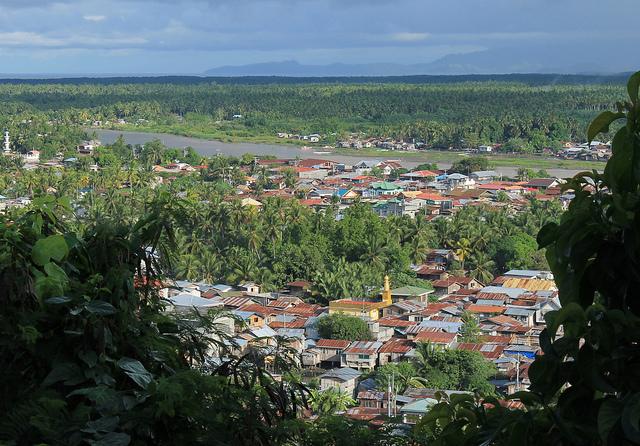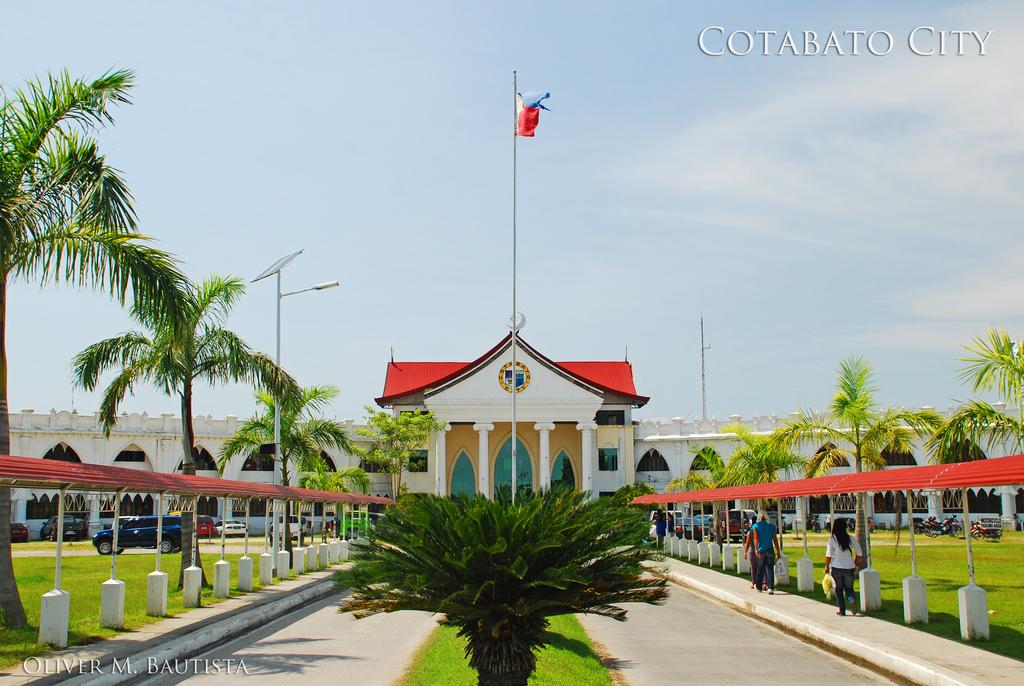
View of Cotabato City from PC Hill
The City of Cotabato (Malay: Kotabatu) is one of the cities of the Philippines located in Mindanao. Cotabato City is an exclave of the SOCCSKSARGEN region found within the boundaries of Maguindanao province, but is independent of that province. Cotabato City is distinct from and should not be confused with the province of Cotabato.
Cotabato City is the regional center of the Autonomous Region in Muslim Mindanao (ARMM) but the city is actually part of the SOCCSKSARGEN region, sometimes grouped with Cotabato in some sources,and does not belong to the ARMM.

The city currently serves as the center for economic support activities (trade and finance), education and other support services such as social, physical, cultural and other basic services of Central Mindanao are offered in the city.
Province History
Cotabato City had witnessed more history than any other place in Mindanao. Its history dates back to the 15th century when Shariff Kabunsuan, an Arab missionary, landed along the banks of the Rio Grande de Mindanao and introduced Islam to the natives. Islam was the faith that moved the early settlers to communal life, and to establish the Sultanate of Maguindanao with its golden age ushered in by Sultan Dipatuan Qudarat during the 17th century the time when Cotabato City developed as the capital town of Maguindanao.
In the nineteenth century, when Sultan Makakua ruled, roads and wharfs were constructed which gave rise to the birth of modern day Cotabato. However, the then Municipality of Cotabato was first organized at the later part of the 19th century when the Spaniards established a military post at Barangay Tamontaka, one of the earliest Christian settlements.
Christianity was introduced in 1870 in the area. Almost a century later it became a city on July 10, 1959. During that time it was the capital of the undivided province of Cotabato.
On July 1, 1950, the then Municipality of Cotabato was made a first class municipality under Executive Order No. 466. Nine Years later, on June 20, 1959, it was created into a chartered city by virtue of Republic Act No. 2364.
During the beginning of the 1950s up to the mid-1960s, Cotabato was by far the second largest and most progressive city in Mindanao, after Davao City. However, mass insurgencies between Christians and local Muslims in the region capitulated the city's economic decline. Now the city is mostly isolated to other important economic centers in Mindanao.
When the Empire Province of Cotabato was dissolved 1967, the city used to be part of the newly-founded North Cotabato province until 1973; since then the city was the administrative center of the ARMM. However, the city broke off administratively from Maguindanao as it rejoined SOCCSKSARGEN in the 1990s. Now some sources consider the city as part of the present Cotabato Province.
Tourist Attractions
Pedro Colina Hill or Tantawan
- A stone fort towering over the city with a height of 90 feet, now houses the Cotabato city Internal Defense Command. This is a Cotabato City's famous landmark, this historic hill served as a watch tower for the natives in their defense drive to detect and repel assaults by enemies. From this hill, one can have a panoramic view of the city, its surrounding areas, and the Rio Grande de Mindanao.
Old Cotabato City Hall
- A vintage Malay inspired architectural design structure showcasing a blend of ethnic culture.
New City Hall
- A majestic structure located at Malagapas, Barangay Rosary Heights 10, combining ethno-modern architectural with Muslim-inspired roof symbolizing its royalty. The entire bureaucracy of the Executive Department is now housed under one roof.
Old Provincial Capitol
- Of early American architecture, it was the seat of the then Empire Province of Cotabato.
Tamontaka Church
- The oldest church, of Spanish architecture and design, was built by the Jesuits. This is where the old settlement was built in 1872. During the 1976 earthquake, a portion of the church collapsed but the Oblate Fathers restored the ruin parts following the original design.
Takumi Butai Memorial Shrine
- Takumi Butai ShrineThe shrine was named after Col. Takumi Butai, the Provincial Commander of the Japanese Imperial Army in the then empire Province of Cotabato during the Second World War. Upon Takumi's request, part of his ashes was enshrined in Cotabato City, a place he considered his second home. The month of August is recognized by the Japanese as All Souls Month. It ushers a sentimental journey of relatives, friends and compatriots back to the city to pay homage to a fallen hero.
Timako Hill
- Overlooking the Illana Bay, it is protected by Bongo Island. The place is a good resort withtimako_hill bluegreen waters, sandy white beach, lake and cave, wooded park and a river, is ideal for camping, skin diving, snorkeling, boating, fishing and other water sports. It likewise offer nature lovers and ideal place for trekking, bird and white monkey watching and other lesure activities. The cultural village which will be set at the foot of the hill is a typical Maguindanao village where people practice the traditional crafts such as brassmaking, malong weaving, mat and basket weaving, boat building and bamboo crafts. It is also a sanctuary for oral and written traditions of the people including lores, legends, dances, songs, rituals and other metaphysical culture of the tribe.
Regional Autonomous Government Center
- It houses almost all regional offices of the Autonomous Region in Muslim Mindanao (ARMM) and has a unique blend of modern and muslim architecture. Within the complex, a guest can visit the regional library, museum and on season can witness cultural spectacles at the Shariff Kabunsuan Cultural Center.
Masla Pulangi or Rio Grande de Mindanao
- Reputedly the second longest river in the country, it is estimated to be 182 kilometers and 96 meters wide. It is not only of aesthetic value but also of economic importance. Water sport and boat racing are the popular attractions of the river, usually held to coincide with the feast of Hariraya Puasa, Hariraya Hadj, Maulidin Nabi, Araw ng Kutabato, Our Lady of Peñafrancia Fiesta and Shariff Kabunsuan Festival.
- Located at the foot of the hill, it is the only cave in the entire country located in the heart of the city. It has four major entrances offering various natural attractions like rock formations, salt water ponds, underground river and an army of fruit bats. It is also rich in historical and cultural legacy, and ideal for guided tour and spelunking.
Many Celebrations of Cotabato City
Shariff Kabunsuan Festival (December 15-19)
- Celebrated in honor of Shariff Mohammad Kabunsuan, an Arab missionary from Johore who planted the seed of Islam in Central Mindanao. With his arrival came the Sultanate form of government and Royal houses, the Madrasah system of education, trade, commerce, to name a few. On this event, dances, traditional games and sports are the regular activities. Highlights include a Dance Parade, Banca Race and the re-enactment of his arrival.
Our Lady of Peñafrancia Fiesta (3rd Sunday of September)
- Celebrated in honor of Our Lady of Peñafrancia, it is preceded with a Holy mass and procession from the Immaculate Conception Cathedral to a waiting landing craft (barge) decked with colorful buntings, banana trunks, flowers and a brass band for its traditional fluvial procession at the Rio Grande to watch or join the procession in fulfillment of a vow, hosted by the Bicolano Association of Cotabato City. This annual event is a replica of the same event in Naga City.
Araw ng Kutabato (June 12-25)
- It is the biggest celebration in all of the city’s festivals. It commemorates the city’s charter anniversary. Officially commencing on Independence Day (June 12), the two weeks of merry making is dotted with events like agri-aqua product showcase, exhibits of photographs and artworks, sports and traditional games and other modern day athletics. Capping the celebration is the selection of the city’s fairest maiden in the Search for the Mutya ng Kutabato and the mammoth civic/military and cultural dance parade dubbed as the Lilang-lilang Festival”.
Immaculate Conception Fiesta (December 8)
- The patroness of Cotabato City, the feast of the Immaculate Conception is held from the first day of December and it is marked by a trade fair, musical presentations, cultural presentations, drums and bugle corps contest and the nightly novena mass in honor of the patroness.
Accommodation
- Grand Rio Hotel - #80 Don Rufino Alonzo Ave.
- Estosan Garden Hotel - Gov. Gutierrez Boulevard
- Hotel Filipino - Sinsuat Avenue
- Diamond Hotel - Cor.Makakua and Jose Lim St.
- Pacific Heights Hotel and The Marqueza - #66 Don. T.V. Juliano Avenue
- Citi Plaza Hotel - Makakua Street
- El Manuel Hotel - 111 Quezon Avenue, El Manuel Drive
- Vision Inn - #48 Notre Dame Avenue
- Azaleas Pension House - 128-I-A Sinsuat Avenue,RS
- Sardonyx Pension House - Gov. Gutierrez Avenue
- Pension Rafael - San Isidro St.
- Fiesta Cotabato - Dr. Rabago St.
- Hotel Cirilo - Sultan Makakua Street
Accessibility
By Air
To Cotabato City
- From Metro Manila 1 hr 30 min
- From Cebu City 45 minutes
- From Zamboanga 25 minutes
To Marawi City (through Cagayan de Oro City)
- From Metro Manila to CDO 1 hr 20 min
- From Cebu City to CDO 35 minutes
(Marawi is 3 hours overland from Cagayan de Oro)
By Sea
- Sulpicio, Negros Navigation, Aboitiz, William and Gothong Lines ply routes from Manila to Cotabato, serving areas of Cotabato province, Cotabato City, and Sultan Kudarat.
- Their Manila-to-Cagayan-de-Oro routes also serve the areas of Iligan, Lanao del Norte, and Marawi City.
By Land ( PUV's like L300 Vans, Jeeps and Buses ply these routes)
- To Cotabato City From Davao City 4 hrs
- To Marawi City From Cagayan de Oro via Iligan 3 hrs
- To Cotabato City From General Santos City 4 hrs
By Bus
From Davao to Cotabato City 6 hrs
Airconditioned Mini-Vans
From Lanao Sur, General Santos City, Tacurong, Marawi City, Kidapawan City to Cotabato City
Jeepneys
From General Santos City, Kidapawan City, Marawi City, all points of the Municipalities of Maguindanao.
Non-aircon/aircon Bus lines
From the city to nearby municipalities and to Davao City. Weena Express, and Grand transport provide service from the north leading to Davao City.
There are many jeepneys and tricycles to get you around the city.
- http://en.wikipedia.org/wiki/Cotabato_City
- http://cotabatocity.net.ph/index.php?option=com_content&view=article&id=69&Itemid=79
- http://cotabatocity.net.ph/index.php?option=com_content&view=article&id=68&Itemid=80
- http://cotabatocity.net.ph/index.php?option=com_content&view=article&id=71&Itemid=78
- http://cotabatocity.net.ph/index.php?option=com_content&view=article&id=70&Itemid=77










